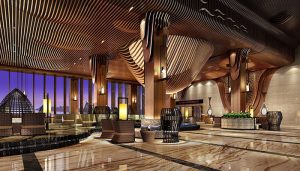A noisy environment is the worst thing for a great meal. Regardless of the type of food you serve, most people just want to dine in a quiet place. But if they are placed in a noisy, crowded restaurant, their entire dining experience could be ruined. And then they may complain and give bad reviews.
That’s why restaurant soundproofing panels are so important for controlling restaurant noise. Soundproofing panels block out loud noises and provide customers with the quiet, comfortable dining space they want.
Today, we will discuss the reasons why soundproof walls are so important for restaurants. In addition, we need to understand the different types of soundproofing panels used in kitchens and how to place them for optimal soundproofing in a restaurant.
Table of Contents
ToggleWhy Soundproofing a Restaurant Is So Important
There are many sources of noise that affect restaurants. Examples include the mess in the kitchen, the sounds people make when they talk, and the noise from traffic and the city outside. They can also be difficult to control, especially if the restaurant is open plan. This is because these sounds can travel around and create reverberations and echoes.
Sadly, these noises can really ruin the dining experience and the impression of the restaurant for customers. Researchers in Australia recently studied how loud background noise affects how much people enjoy their meals. To understand how people in restaurants react to different types of noise, they used three noise sources:
- Traffic noise
- Normal noise in the restaurant
- Music that calmed people down
It’s not surprising that test subjects didn’t like the first two types of noise. Regardless of decibel (dB) levels, customers reported that traffic noise and restaurant noise made their meals less enjoyable. The louder the noise, the stronger the feeling.
In contrast, some diners reported that listening to soothing music during their meal made them enjoy their meal more. But only if the music is not too loud. Listening to music is most helpful when the volume is around 30 decibels (the volume of a whisper).
Low to No Maintenance Interior Acoustic Panels
In a world filled with noise, acoustic panels emerge as the elegant solution to create serene environments.
View MoreDifferent Types of Ceilings and Acoustic Panels
Different types of acoustic ceilings for restaurants block out noise and make the space quieter. Acoustic panels reduce echoes because they stop sound from bouncing off hard objects like ceilings. This reduces the energy of the noise so that it disappears before it gets louder.
Restaurants can reap multiple benefits from acoustic ceilings:
- As mentioned earlier, acoustic ceilings help reduce noise levels and make dining more enjoyable.
- Unlike any other type of ceiling material, acoustic ceilings have a unique look.
- They are made of fire-resistant materials such as fiberglass. So you don’t have to worry about placing them near gas stoves, hot surfaces, or things that could catch fire.
Restaurants can also benefit greatly from standard acoustic panels. This is because they help control noise problems. These thick, porous panels are placed on walls and other surfaces to absorb noise in the room. They are important for restaurants because they can provide the following benefits:
- Acoustic wall panels are installed on the walls to reduce noise in the room.
- Soundproofing panels between booths to minimize noise and keep conversations private.
- Separate noisy areas where food is prepared from quieter dining areas.

Setting Up and Maintaining Soundproofing Solutions
Are you interested in a quiet dining area but are afraid of installing soundproofing materials? Don’t worry! Installing acoustic panels is as easy as putting together building blocks.
There isn’t much you need to do to secure most acoustic panels in place. You can follow these steps to start with:
- Find and mark the exact location where you want to install the acoustic panels.
- using the adhesive supplied by the acoustic panel manufacturer, draw a line on the back of the acoustic ceiling and then join the corners in an X-shape.
- Alternatively, you can use contact adhesive spray to fill in the gaps.
- Start installing the acoustic panels at the exact locations you marked. After installing the acoustic panel, press down twice: first on the edges to allow the adhesive to stick, and then in the center to make sure it stays in place.
- Repeat this until you are satisfied. During this process, smooth the joints of adjacent acoustic panels.
Many acoustic ceilings can be laid in the same way. In fact, some acoustic panels, such as COOWIN’s range of acoustic panels and tiles, can be used for both walls and ceilings. Installing a suspended ceiling is even easier if a grid is already in place. Simply take out the old ceiling, lay in the new ceiling and you’re done!
In general, acoustic walls don’t require much maintenance. On the other hand, in a restaurant, food and drink splatters and other sticky substances can stain the walls. Wipe up any spills with a damp cloth or a cleaner that won’t scratch until the spots are gone.

Case Studies of Effective Acoustical Implementation
Many businesses in the U.S. have solved noise problems with acoustic panels. Acoustic panels work just as well in busy bars and breweries.
One noisy brewery has what its owner calls an “echo chamber.” It was annoying because the sound reverberated throughout the large industrial area. They solved the problem when they installed a series of acoustic panels and acoustic ceilings at the top of the walls. The echoes disappeared immediately and no longer bothered the people who worked there.
Summary
People just don’t like restaurants that are too loud. Eliminating background noise in a restaurant will make the dining experience better for customers, turning casual customers into regulars. The best way to eliminate echoes, keep conversations private, and reduce noise in the dining area is to use acoustic panels and ceilings.
Consult the experts at COOWIN to learn more about soundproofing restaurants, the different types of acoustic panels, and how to effectively block noise. We know a thing or two about soundproofing and other acoustic solutions. We’re ready to help you solve your sound problems with what we know.







